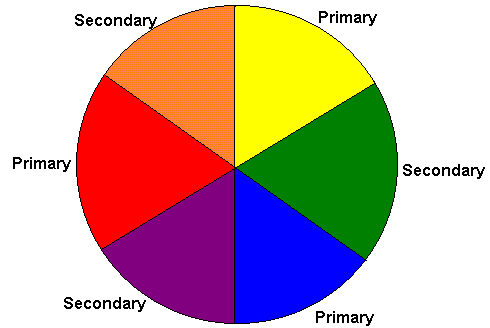

The color wheel is a representation of how colors interact to create one another. Colors are divided into primary, secondary and tertiary.
 Primary Colors... red, blue and yellow are the pure hues that all other colors are derived from. They are not mixed from any other colors. They are spaced equidistant from one another on the color wheel.
Primary Colors... red, blue and yellow are the pure hues that all other colors are derived from. They are not mixed from any other colors. They are spaced equidistant from one another on the color wheel.
 Secondary Colors... orange, green and violet are the three colors mixed from equal amounts of two primary colors. For example: Red + Yellow = Orange, Yellow + Blue = Green or Red + Blue = Violet, etc.)
Secondary Colors... orange, green and violet are the three colors mixed from equal amounts of two primary colors. For example: Red + Yellow = Orange, Yellow + Blue = Green or Red + Blue = Violet, etc.)
 Tertiary Colors... result when a primary color is combined with its nearest secondary color on the color wheel. Examples are blue-green, yellow-green, yellow-orange, red-orange, red-purple, blue-purple and so on.
Tertiary Colors... result when a primary color is combined with its nearest secondary color on the color wheel. Examples are blue-green, yellow-green, yellow-orange, red-orange, red-purple, blue-purple and so on.
 Complementary... colors directly opposite each other on the color wheel. For example: Red and Green; Blue and Orange; Yellow and Violet. These colors can make a lively decorating scheme, but they need deft handling to avoid overpowering a room.
Complementary... colors directly opposite each other on the color wheel. For example: Red and Green; Blue and Orange; Yellow and Violet. These colors can make a lively decorating scheme, but they need deft handling to avoid overpowering a room.
 Harmonies... closely related colors that lie between two primaries on the color wheel, such as: blue, blue-violet, and violet.
Harmonies... closely related colors that lie between two primaries on the color wheel, such as: blue, blue-violet, and violet.
 Hue... an identifying name for a specific color, such as sea green, apple green or hunter green.
Hue... an identifying name for a specific color, such as sea green, apple green or hunter green.
 Tone... defines the lightness or darkness of a color.
Tone... defines the lightness or darkness of a color.
 Tint... are colors that are cloest to white, such as pastels. Add red to white, and the result is pink. These are considered light tones.
Tint... are colors that are cloest to white, such as pastels. Add red to white, and the result is pink. These are considered light tones.
 Shades... are made by adding black to a color. Navy, maroon, midnight blue, and deep purple are good examples of this shade. These are considered dark tones.
Shades... are made by adding black to a color. Navy, maroon, midnight blue, and deep purple are good examples of this shade. These are considered dark tones.
 Neutrals... are welcome in any decorating scheme because they are so easy on the eyes. Black, white, grey, brown and beige are all examples of neutral hues.
Neutrals... are welcome in any decorating scheme because they are so easy on the eyes. Black, white, grey, brown and beige are all examples of neutral hues.
 Monochromatic Color Schemes... are based on a single hue. Spice this scheme with variations of the major color for visual interest. In choosing design element sand surfaces, a textural mix is especially important.
Monochromatic Color Schemes... are based on a single hue. Spice this scheme with variations of the major color for visual interest. In choosing design element sand surfaces, a textural mix is especially important.
 Analogous Color Schemes... use closely related colors, those adjacent on the color wheel. Such secondary and tertiary colors harmonize well. The scheme can embrace three to five hues, but only one primary color. An example is a room in blue, blue-green and green.
Analogous Color Schemes... use closely related colors, those adjacent on the color wheel. Such secondary and tertiary colors harmonize well. The scheme can embrace three to five hues, but only one primary color. An example is a room in blue, blue-green and green.
 Complementary Color Schemes...combine colors directly opposite each other on the color wheel. These bold-spirited rooms succeed best when one color is used more liberally than the others.
Complementary Color Schemes...combine colors directly opposite each other on the color wheel. These bold-spirited rooms succeed best when one color is used more liberally than the others.
Some of the information contained above was taken from Better Home and Gardens New Decorating Book by Gerald M. Knox, editor.
� 1998 [email protected]